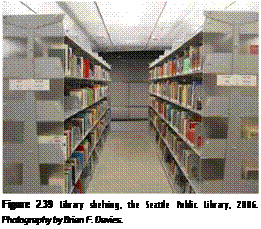Institutional furnishings are used in classrooms, libraries, and training facilities. The phrase contract furniture is
used to describe institutional furniture.
On occasion, institutional furnishings are custom designed for specific places, but generally they are anonymous products. Stackable chairs such as Arne Jacobsen’s Series 7 (Figure 2.36) and David Rowland’s 40/4 stacking chair (Figure 2.37) were designed for conferencing, auditorium seating, and institutional use. The best designs are durable, comfortable, flexible, lightweight, and easy to store. Arne Jacobsen’s Ant chairs are available in three – and four – leg versions, with or without arms, and in a variety of back profiles. The 40/4 stacking chair (1963) can be stacked 40 high within a space of 4 feet (1.2 m) because the chair nests closely and the frame is made of 7/16-inch (11 mm) diameter high-strength steel rod. Over 8 million 40/4 stacking chairs have been produced, and many are still in use around the world.

 Design criteria for institutional seating include:
Design criteria for institutional seating include:
■ Lumbar vertebrae support
■ The ease with which and number of chairs that can be stacked (4 to 40)
■ Lightweight design
■ Comfort and freedom for body movement
■ Gauge of the metal supports (16-gauge and 7/8- inch [2 cm] tubing are standard)
■ Durability
■ Stain and scratch resistance of the chair’s finish
■ Price
Fixed institutional seating includes educational lecture seating, auditorium seating, theater seating, stadium seating, and courtroom seating. The folding auditorium seating designed by Poul Kjsrholm and in collaboration with cabinetmaker Ejnar Pedersen (1976) is attached to a stepped floor in the concert hall at the Louisiana Museum of Modern Art in Humlebaek, Denmark. The seating incorporated plaited maple seat pans and backs (woven slats) that were remarkable for both their craft and comfort (Figure 2.38). The maple slats complemented the dark wood flooring, but the plaited inserts caused a distracting noise from maple rubbing against maple. Wax and soap flakes were applied in an attempt to address the problem but without success. Eventually, the maple inserts were replaced with ash wood by P P. Mobler, which solved the noise problem.
Fixed seating often incorporates extendable writing tablets or cup holders. These elements should be accessible, easy and quiet to operate, and durable. Most writing tablets are designed to favor right-handed users because 90 percent of the population is righthanded, but the challenge remains to accommodate all users.
Shelving systems are important institutional furnishings, particularly in libraries. They need to be flexible, adjustable, accessible, and durable. Wall-mounted or freestanding shelving systems can define and partition space in a significant manner (Figure 2.39).


